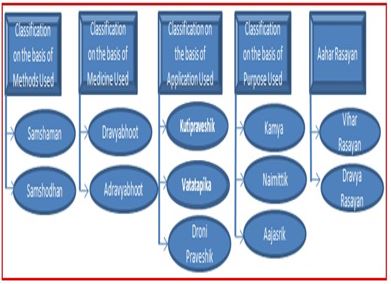A review article on the concept of Rasayan in Ayurveda
Keywords:
Rasayan, Ashtang Ayurveda, Rasa, Dhatu, Achar Rasayan, AyurvedaAbstract
Ayurveda is the ancient system of medicine in the world. This science of life deals with every aspect of life. Ayurveda has two aims i.e., Promotion of Health and Cure from disease. Rasayan may be employed for ful-filling both of them. Rasayan are the ways of attaining excellent Ras i.e., Attains longevity, memory, intelligence, freedom from disorders, youthful age, excellence of luster, complexion and voice, ultimate strength of physique and sense organs, wisdom and successful words and brilliance. Rasayan also called a Rejuvination therapy is one considered under Ashtang Ayurveda. Rasayan drugs are those which are capable of importing superior Rasas and Dhatus to the body and toning up the system of healthy persons. Rasayan aids in increasing natural immunity enhancing general wellbeing, improving the functioning of all the fundamentals organs of the body and keep the signs of early ageing at bay. Moreover, it involves two opposite processes that simultaneously come into operation i.e., growth and atrophy. Ageing represents structural and functional changes of an organism over its entire life span. Rasayan is not a drug therapy but it is a specialized procedure practiced in the form of rejuvenate recipes, dietary regimes and special health promoting conduct and behaviour i.e., Achar Rasayan.
Downloads
References
Kashinath Shastri, Gorakha Natha Chaturvedi, Charaka Samhita with Elaborated Vidyotini Hindi Commentary, Sutrasthana, Chaukhambha Bharti Academy, Varanasi, 2005, p.587.
Atrideva Gupta, Ashtanga Hridyam, Edited with Vidyotini Hindi Commentary, Sutrasthana, Chapter 1 verse 5, Chaukhambha Prakshan, Varanasi. 2016, p.3
Ajay Kumar Sharma, Kayachikitsa-IV, Chaukhambha Orientalia, Delhi, 2014, p.310.
Acharya Y T, Shusruta Samhita, Edited with Nibandha Sangraha Teeka, Chikitsa Sthana, Chapter 27 verse 1, Chaukhambha Sanskrit Sansthana. Varanasi. 2009, 0498
Eric L. Teasdale, Workplace stress. Psychiatry, July2006. Vol.5(7):251-254.
http://scroll.in/article/812278/ Every day, India sees 10 suicides related to drug abuse and only one of them is from Punjab.
Ajay Kumar Sharma. Kavachikitsa-IV. Chaukhambha Orientalia. Delhi, 2014, p.322.
Kashinath Shastri, Gorakha Natha Chaturvedi, Charaka Samhita with Elaborated Vidyotini Hindi Commentary, Chikitsasthana, Chapter 1-3 verse 30-31, Chaukhambha Bharti Academy, Varanasi,1998, р.39
Kashinath Shastri, Gorakha Natha Chaturvedi, Charaka Samhita with Elaborated Vidyotini Hindi Commentary, Chikitsasthana, Chapter 1-4, verse 26, Chaukhambha Bharti Academy, Varanasi. 1998, p. 58.
Agnivesha, “Charak Samhita”, with Charak Chandrika Hindi commentary, by Dr. Brahmanand Tripathi and Ganga SahayPandey, Chikitsa Sthana Chapter 1/1, Verse No. 5. Page.4. Chaukhamba Surbharti Prakashan, 2007.
Ambikadutta Shastri, Shusruta Samhita, Edited with Ayurveda Tattva Sandipika, Sutrasthana, Chapter 15 verse 3, Chaukhambha Sanskrita Sansthana, Varanasi, 2003, p.56.
Kashinath Shastri,'Gorakha Natha Chaturvedi, Charaka Samhita with Elaborated Vidyotini Hindi Commentary, Chikitsasthana, Chapter 15 verse 3-5, Chaukhambha Bharti Academy, Varanasi, 1998, р. 452-453.
Kashinath Shastri, Gorakha Natha Chaturvedi, Charaka Samhita with Elaborated Vidyotini Hindi Commentary, Chikitsasthana, Chapter 1-1 verse 7-8, Chaukhambha Bharti Academy, Varanasi, 1998, p. 5.
Ambikadutta Shastri, Shusruta Samhita, Edited with Ayurveda TattvaSandipika, Chikitsasthana, Chapter 27. verse 3, Chaukhambha Sanskrita Sansthana, Varanasi, 2003, p. 120
Brahmanand Tripathi, Sharangdhara Samhita, Dipika Hindi Commentary, Purva Khanda, Chapter 6 verse 62, Chaukhambha surbharti Prakashan, Varanasi, 2007, p.86
Ambikadutta Shastri, Shusruta Samhita, Edited with Ayurveda Tattva Sandipika, Sutrasthana, Chapter 15 verse 48, Chaukhambha Sanskrita Sansthana, Varanasi, 2003, p.64.
R. Govindarajan, M. Vijayakumar, P. Pushpangadan, Antioxidant approach to disease management and the role of Rasayana herbs of Ayurveda, Joural of Ethnopharmacology: 99 (2005);165178
Puri, H.S., 2003. 'Rasayana'-Ayurvedic herbs for longevity and rejuvenation. Taylor and Francis, London.
Kumar, P., Kuttan, R.V., Kuttan, G.G,1994. Chemoprotective action of 'Rasayana' against cyclophosphamide toxicity. Tumori 80, 306308.
Vayalil PK, Kuttan G Kuttan R. Rasayanas: evidence for the concept of prevention of diseases. Am J Chin Med, 2002: 30(1): 155-71.















